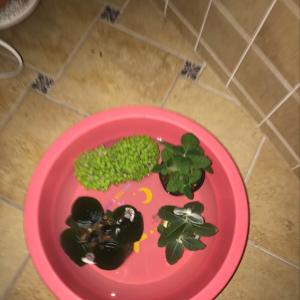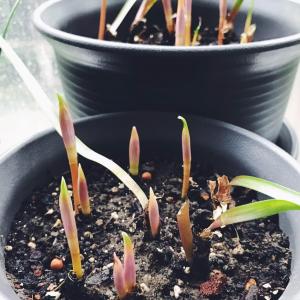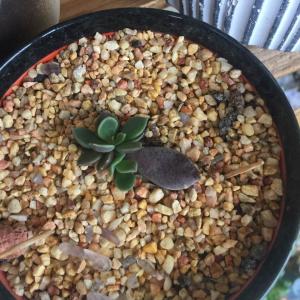成长记
蜜儿
2017年08月08日

14:30
米兰可能要开花的
两种芽都不一样
而经过我这两天的观察
那叶心里灰色的芽会舒展成叶子
白色的芽没注意过
看来自家种出来的米
洗出的淘米水挺不错


米兰可能要开花的
两种芽都不一样
而经过我这两天的观察
那叶心里灰色的芽会舒展成叶子
白色的芽没注意过
看来自家种出来的米
洗出的淘米水挺不错


0
0
文章
Dummer. ゛☀
2017年08月07日

Freesia is a genus of about 14 species. Freesia bulbs are usually grown for use asCut Flowers. All the 14 species of Freesia are African in origin. Of The 14 Freesia species, 12 are native to Cape Province, South Africa, the remaining two to tropical Africa, with one these species extending north of the equator to Sudan. Freesia flowers are very fragrant, typically white or yellow, and are borne in spikelike racemes. This blooming beauty captures your heart and is a springtime favorite.
Freesia plants grow from a corm (a solid bulb, as in Gladiolus). The Freesia orm sends up a tuft of long narrow leaves and a slightly branched stem. Freesia Flowers are borne as loose one-sided spikes of narrowly funnel-shaped flowers along a side few leaves. Some excellent Freesia varieties (old-fashioned) for fragrance include: Athene, Allure, Demeter, Excelsior, Golden Wave, Mirabel, Pink Westlind, Snowdon, and Welkin.
The tender, cormous plant, Freesia originated in South Africa. The leaves on Freesia are sword shaped and light green and may be up to 1 feet high. Freesia Flower stalks are slender and about the same height. As many as 8 funnel-shaped Freesia flowers form a loose cluster at the top of each stalk. Where the flowers begin, the stem makes a sharp bend so that the Freesia flowers face upward.
Facts About Freesia
Freesia bloom was named by Dr. Freese (1785-1876) , a native of Kiel, Germany.
The flowers come in a great variety of colors - white, golden yellow, orange, red, pink, mauve, lavender, purple and bicolors.
Freesia perfume has a light, sweet, soap-like floral scent - trendy in soaps, lotions and so forth.
Freesia flower bouquets are also used for gifting on special occassions. Freesia flowers are symbolic of innocence.
Freesia are very poularly used in the perfume, scented oils and baths and other related industries.
Freesia Fragrance Oil
Fragrance Oils are artificially created fragrances, which contain artificial substances. Freesia fragrance oil is suitable for use in oil burners and vapourisers. It can also be used to refragrance pot pourries. Freesia fragrance oil can also be used in any of the vapourisers, such as the ceramic lamp ring, drivetime car vapouriser, radiator vapouriser or mini vaporiser.
Freesia essence oil is uncut, undiluted, alcohol free, long lasting, high grade essence oil. The oil is excellent for aromatherapy uses - to scent candles, freshen potpourri, in soap making, massage oils, bath oil and of course, as a Freesia perfume body oil - to smell just truly great.
Growing Freesia Flowers
The corms should be planted close - six will do nicely in a 5 inch pot.
Soil should be light and should be drained well.
Place the top of the corm, 1 inch below the soil.
For winter flowers, plant freesia in late summer or early fall and keep them cool until frosts are due.
During winter, bring freesia bulbs in and keep them in a sunny window.
Plant Care
Freesias are propagated by offsets of bulbs and seeds.
Freesia plants need full sun and cool night temperatures, preferably between 45 and 40 degrees.
Keep the plants well watered while the leaves and flowers are developing.
When the leaves begin to brown after the flowers have faded, the plants may be gradually dried off and the corms saved for the following year.

Freesia plants grow from a corm (a solid bulb, as in Gladiolus). The Freesia orm sends up a tuft of long narrow leaves and a slightly branched stem. Freesia Flowers are borne as loose one-sided spikes of narrowly funnel-shaped flowers along a side few leaves. Some excellent Freesia varieties (old-fashioned) for fragrance include: Athene, Allure, Demeter, Excelsior, Golden Wave, Mirabel, Pink Westlind, Snowdon, and Welkin.
The tender, cormous plant, Freesia originated in South Africa. The leaves on Freesia are sword shaped and light green and may be up to 1 feet high. Freesia Flower stalks are slender and about the same height. As many as 8 funnel-shaped Freesia flowers form a loose cluster at the top of each stalk. Where the flowers begin, the stem makes a sharp bend so that the Freesia flowers face upward.

Facts About Freesia
Freesia bloom was named by Dr. Freese (1785-1876) , a native of Kiel, Germany.
The flowers come in a great variety of colors - white, golden yellow, orange, red, pink, mauve, lavender, purple and bicolors.
Freesia perfume has a light, sweet, soap-like floral scent - trendy in soaps, lotions and so forth.
Freesia flower bouquets are also used for gifting on special occassions. Freesia flowers are symbolic of innocence.
Freesia are very poularly used in the perfume, scented oils and baths and other related industries.
Freesia Fragrance Oil
Fragrance Oils are artificially created fragrances, which contain artificial substances. Freesia fragrance oil is suitable for use in oil burners and vapourisers. It can also be used to refragrance pot pourries. Freesia fragrance oil can also be used in any of the vapourisers, such as the ceramic lamp ring, drivetime car vapouriser, radiator vapouriser or mini vaporiser.
Freesia essence oil is uncut, undiluted, alcohol free, long lasting, high grade essence oil. The oil is excellent for aromatherapy uses - to scent candles, freshen potpourri, in soap making, massage oils, bath oil and of course, as a Freesia perfume body oil - to smell just truly great.

Growing Freesia Flowers
The corms should be planted close - six will do nicely in a 5 inch pot.
Soil should be light and should be drained well.
Place the top of the corm, 1 inch below the soil.
For winter flowers, plant freesia in late summer or early fall and keep them cool until frosts are due.
During winter, bring freesia bulbs in and keep them in a sunny window.
Plant Care
Freesias are propagated by offsets of bulbs and seeds.
Freesia plants need full sun and cool night temperatures, preferably between 45 and 40 degrees.
Keep the plants well watered while the leaves and flowers are developing.
When the leaves begin to brown after the flowers have faded, the plants may be gradually dried off and the corms saved for the following year.
1
1
文章
Miss Chen
2017年08月06日


Description: This perennial plant consists of a rosette of basal leaves up to 1½' across and one or more flowering stalks up to 2½' tall. The strap-shaped basal leaves are up to 14" long and 1" across; they are linear, smooth along the margins, and glabrous. Their veins are parallel. These basal leaves are rather floppy and they often arch downward or sprawl across the ground in the absence of support from other vegetation. The basal leaves wither away by mid-summer. The flowering stalks are erect, slender, hairless, and leafless. Each stalk terminates in a raceme of about 20-80 flowers. Each flower consists of 6 lavender to pale blue-violet tepals, 6 stamens with golden yellow anthers, and a light green pistil with a short slender style. Each flower spans about ¾" across when it is fully open. The pedicels of the flowers are slender, green, and deciduous, unless the flower is successfully cross-pollinated. Underneath each flower, there is often a persistent bract about ¾" long that is thread-like in appearance. After the flowers begin blooming on the raceme, there can be 3-20 (or more) of these bracts underneath. Several flowers bloom in a ring at the same time, which forms at the bottom of the raceme and moves upward. The blooming period occurs from late spring to early summer and can last up to 1 month for a colony of plants. The flowers that are successfully cross-pollinated form seed capsules that are ovoid-oblongoid in shape. Each capsule contains several seeds. The root system consists of a bulb with secondary fibrous roots at the bottom. This plant reproduces by forming offsets from the bulbs and by reseeding itself.
Cultivation: The preference is full or partial sun, moist to mesic conditions, and a fertile loamy soil. This plant is rarely bothered by disease and insect pests. It is somewhat slow to develop, especially from seeds.
Range & Habitat: In Illinois, Prairie Hyacinth is a rare plant that has been observed in Macon and Peoria counties only (see Distribution Map). At the present time, only one population of plants is known to exist within the state at a railroad prairie. Apparently, the other population has been extirpated. In neighboring states, Prairie Hyacinth has been observed in prairies and thinly-wooded areas. This native species is state-listed as 'endangered' in Illinois.
Faunal Associations: The flowers attract both long-tongued and short-tongued bees, which suck nectar or collect pollen. Other visitors of the flowers include various flies, butterflies, skippers, wasps, and beetles, which suck nectar or feed on pollen. Aside from these flower-visiting insects, little information is available about floral-faunal relations for this wildflower.
Photographic Location: The webmaster's wildflower garden in Urbana, Illinois.
Comments: This little-known species is sometimes confused with Camassia scilloides (Wild Hyacinth), which is more common within the state. Both species are attractive wildflowers with similar habitat preferences. Their appearance is quite similar, which can make them difficult to tell apart. Prairie Hyacinth begins to flower about a month later than Wild Hyacinth and there is little overlap in their blooming periods; this is one good reason why they should be considered separate species. The flowering stalk of Prairie Hyacinth has 3-20 (or more) persistent bracts underneath the blooming flowers, while Wild Hyacinth has 0-2 deciduous bracts underneath the flowers of its stalks. The seed capsules of Prairie Hyacinth are longer than they are wide, while the seed capsules of Wild Hyacinth are about as long as they are wide. The flowers of Prairie Hyacinth tend to have shorter styles, shorter stamens, and tepals that are a little shorter and more deeply colored, but these distinctions are less reliable, or they require the careful use of a ruler or measuring tape in the field.
0
0
文章
Dummer. ゛☀
2017年07月18日

Family - Brassicaceae
Stems - To +20cm tall, erect, herbaceous, from a taproot, pubescent below, less so to glabrous above, often reddish in strong sun, typically branching near the base.

Leaves - Alternate, pinnately divided (pinnatifid) with 5-14 divisions on each side of the axis, to +4cm long, +1cm broad. Petioles and rachis pubescent. Divisions of the leaves acute, reduced basally, typically entire or with a small basal lobe, subulate to lanceolate glabrous or with one or two hairs near the apex. Leaves overwintering as a basal rosette.

Inflorescence - Terminal and axillary racemes, compact in flower, quickly expanding in fruit to more than 2/3 of the total plant height. Pedicels short (1-3mm) in flower, elongating to +4mm in fruit, glabrous.
Flowers - Petals 4, white, distinct, to 3mm long, 1mm broad, rounded at the apex, glabrous. Stamens 6, erect. Filaments to -2mm long, glabrous, translucent-white. Anthers yellow, .2mm long. Ovary cylindric, green to purple, glabrous, 1-2mm long in flower, quickly expanding. Style wanting. Sepals 4, distinct, whitish-green to purplish in strong sun, erect, glabrous, to 2mm long, 1mm broad, oblong-lanceolate, subacute to blunt at the apex. Fruits to +2cm long, 2mm broad, glabrous, moderately compressed ascending, with a -1mm long beak, 2-valved, divided by a septum, with +/-15 seeds per valve.

Flowering - March - May.
Habitat - Disturbed sites, waste ground, fallow fields, cultivated fields, roadsides, railroads.
Origin - Native to U.S.
Other info. - This little weedy species can be found mainly in the southern 2/3 of Missouri. The plant can be identified by its pinnately divided leaves, pubescent stems, small white flowers, and slightly compressed fruits.
Stems - To +20cm tall, erect, herbaceous, from a taproot, pubescent below, less so to glabrous above, often reddish in strong sun, typically branching near the base.

Leaves - Alternate, pinnately divided (pinnatifid) with 5-14 divisions on each side of the axis, to +4cm long, +1cm broad. Petioles and rachis pubescent. Divisions of the leaves acute, reduced basally, typically entire or with a small basal lobe, subulate to lanceolate glabrous or with one or two hairs near the apex. Leaves overwintering as a basal rosette.

Inflorescence - Terminal and axillary racemes, compact in flower, quickly expanding in fruit to more than 2/3 of the total plant height. Pedicels short (1-3mm) in flower, elongating to +4mm in fruit, glabrous.
Flowers - Petals 4, white, distinct, to 3mm long, 1mm broad, rounded at the apex, glabrous. Stamens 6, erect. Filaments to -2mm long, glabrous, translucent-white. Anthers yellow, .2mm long. Ovary cylindric, green to purple, glabrous, 1-2mm long in flower, quickly expanding. Style wanting. Sepals 4, distinct, whitish-green to purplish in strong sun, erect, glabrous, to 2mm long, 1mm broad, oblong-lanceolate, subacute to blunt at the apex. Fruits to +2cm long, 2mm broad, glabrous, moderately compressed ascending, with a -1mm long beak, 2-valved, divided by a septum, with +/-15 seeds per valve.

Flowering - March - May.
Habitat - Disturbed sites, waste ground, fallow fields, cultivated fields, roadsides, railroads.
Origin - Native to U.S.
Other info. - This little weedy species can be found mainly in the southern 2/3 of Missouri. The plant can be identified by its pinnately divided leaves, pubescent stems, small white flowers, and slightly compressed fruits.
0
0
文章
Colour_
2017年07月04日
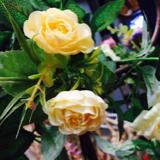
天竺葵适宜在春季或秋季扦插,一般土温保持在11~12℃,10~14天即可生根。新老枝条都能插活,但以强剪之后新萌发的嫩枝为最好。可结合秋季换盆,将剪下的枝条剪成长10~15厘米的插条,待切口干燥后插入素沙土中,插后浇1次透水,以后找水保持湿润,1个月左右可生根发芽。冬季或早春剔下过密的枝条,扦插也很容易成苗。播种时应用单瓣的天竺葵种子,播种繁殖有可能选出优良类型。
天竺葵喜凉爽、怕湿热,室温在10~15℃的向阳房间最适合。天竺葵因生长快、开花多,需要每年换盆。早春正值开花季节,6月开花后,又处于不适它生长的湿热季节,以8月下旬至9月上旬换盆为宜。换盆前要进行修剪,将过密枝、纤细枝、病虫枝及徒长枝,一并从基部剪去,留分布均匀的主枝3~5个,然后再将主枝及侧枝再短截,每个侧枝仅留3个侧芽,使整个植株枝条分布均匀、紧凑,株形丰满矮壮。用腐熟饼肥、骨粉等作基肥,栽后2天才能浇水。
天竺葵根系多肉质,性喜干燥而忌水湿。夏季气温高在35℃以上时,天竺葵呈半休眠状态,要严格控制浇水,以盆土不过干即可,同时以早晚浇水为宜,中午土温较高时切不可浇水,防止引起根须腐烂。
10月初天气转凉时,晚上把盆花搬进房内。当室外白天气温降低到5时,固定在室内有阳光处养护,浇水要见土面发白再浇,浇水后松土。天竺葵喜干,盆土不可积水久湿。每周转盆1次,使叶面均匀着光,以保持棵形匀称美观。天竺葵叶面生有绒毛,易着尘土污染,可在晴天时,搬出室外用温水冲洗干净,不要经常向叶面洒水,以免污垢影响观赏。
天竺葵喜凉爽、怕湿热,室温在10~15℃的向阳房间最适合。天竺葵因生长快、开花多,需要每年换盆。早春正值开花季节,6月开花后,又处于不适它生长的湿热季节,以8月下旬至9月上旬换盆为宜。换盆前要进行修剪,将过密枝、纤细枝、病虫枝及徒长枝,一并从基部剪去,留分布均匀的主枝3~5个,然后再将主枝及侧枝再短截,每个侧枝仅留3个侧芽,使整个植株枝条分布均匀、紧凑,株形丰满矮壮。用腐熟饼肥、骨粉等作基肥,栽后2天才能浇水。
天竺葵根系多肉质,性喜干燥而忌水湿。夏季气温高在35℃以上时,天竺葵呈半休眠状态,要严格控制浇水,以盆土不过干即可,同时以早晚浇水为宜,中午土温较高时切不可浇水,防止引起根须腐烂。
10月初天气转凉时,晚上把盆花搬进房内。当室外白天气温降低到5时,固定在室内有阳光处养护,浇水要见土面发白再浇,浇水后松土。天竺葵喜干,盆土不可积水久湿。每周转盆1次,使叶面均匀着光,以保持棵形匀称美观。天竺葵叶面生有绒毛,易着尘土污染,可在晴天时,搬出室外用温水冲洗干净,不要经常向叶面洒水,以免污垢影响观赏。
0
0
文章
权问薇
2017年05月30日

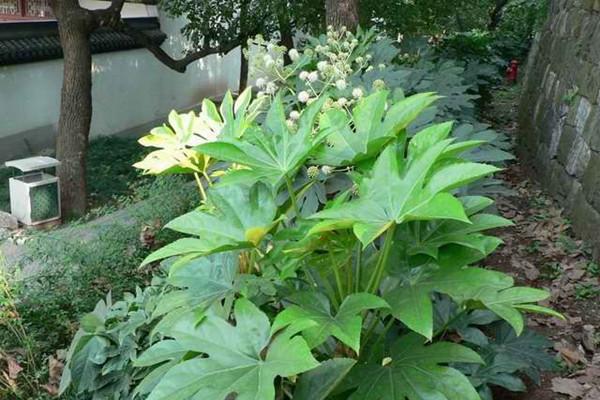
八角金盘的扦插繁殖
八角金盘的扦插繁殖是最常用的一种繁殖方法,扦插繁殖在春季4月份进行或者再秋季的8月进行。
秋季扦插的时候选择已经生长了两年的枝条,截剪成14厘米长的插穗,插穗的剪口要斜着剪,然后将插穗斜插入沙床上。再进行保湿,在沙床上方用塑料薄膜覆盖,注意遮阴。
夏季扦插时,要选用新生的嫩枝条,将枝条截剪成10厘米左右的插穗,让后将插穗浸泡在清水里,保湿一段时间,看到插穗湿润即可取出,一般在一天左右就可以从水里取出了,然后插到沙床里,浇水,用塑料薄膜盖住沙床,保湿遮阴即可。
这两个时段的扦插都会在插好一个月左右就会生根发芽,这个时候就要注意除草,喷水保湿,等生长一年以后就可以移栽了,要注意,带土移栽。
八角金盘的分株繁殖
八角金盘的分株繁殖时必须结合八角金盘换盆的时候进行。
首先把已经长满了的植株,从盆里倒出来,要轻缓,以免伤到根部,倒出来以后,检查根部,看看有没有生长不良的根,如果有,就把它剪除,保证其它根正常生长。
其次要把倒出来修剪好的植株切开,切成数株,再将每株栽植到不同的盆里放到通风阴凉处进行养护。
最后,要注意分株繁殖要随分随种,保证成活率。在生长3个周左右后就可以正常护理,要时常晒太阳,补充光照,还要浇水保湿,施肥补充生长养分。
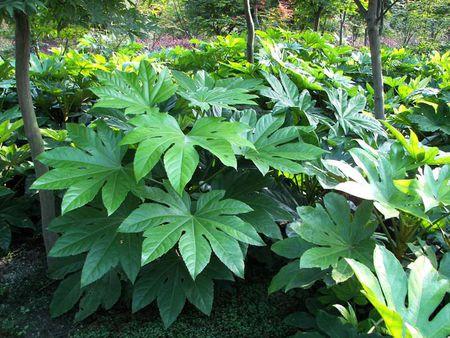
0
0
文章
查理
2017年05月26日

玫瑰花语大全:玫瑰花是美神的化身,是爱情之花,特别是2月14日情人节,在爱情河畅游的年轻人,都会用此花献给自己的心上人来表达爱意。美国、英国、保加利亚、罗马尼亚把玫瑰花作为国花,在中国的北京、天津、南昌、衡阳玫瑰花被设定为市花。玫瑰花语:爱情,高贵,爱与美,容光焕发,纯洁的爱,美丽的爱情,美好常在。
依数目分类
单枝蓝色妖姬:相守是一种承诺
双枝蓝色妖姬:相遇是一种宿命
三枝蓝色妖姬:你是我最深的爱恋
1朵:你是我的唯一
2朵:世界上只有你和我
3朵:I LOVE YOU
4朵:誓言、承诺
5朵:无悔
6朵:顺心如意、顺利、永结同心、愿你一切顺利
7朵:喜相逢
8朵:贵弥补、歉意、弥补、深深歉意、请原谅我
9朵:长相守、坚定
10朵:十全十美
11朵玫瑰花语:爱你一生一世
12朵:全部的爱比翼双飞、圆满组合、心心相印、每日思念对方
13朵:暗恋
14朵:骄傲
15朵:守住你的人
16朵:一帆风顺
17朵:伴你一生
18朵:青春美丽
19朵玫瑰花语:爱的最高点
20朵:两情相爱
21朵:最爱
22朵:双双对对、两情相悦、你浓我浓
24朵:思念、纯洁的爱
30朵:请接受我的爱
33朵:三生三世
36朵:我的爱只留给你
40朵:誓死不渝的爱情
44朵:至死不渝、山盟海誓、恒古不变的誓言
48朵:挚爱
50朵:无悔的爱
51朵:我心中只有你
57朵:吾爱吾妻
56朵:吾爱
66朵:顺利、事事顺利、情场顺利、六六大顺、细水长流我的爱永远不变
77朵:喜相逢、求婚、情人相逢、相逢自是有缘
88朵:弥补歉意、用心弥补一切的错
99朵:天长地久
100朵:白头偕老
101朵:直到永远的爱
108朵:求婚
111朵:一生一世只爱你一个
123朵:爱情自由、自由之恋
144朵:爱你生生世世、12×12爱你日日月月生生世世
365朵:天天爱你
999朵:无尽的爱天长地久,爱无止休长相厮守、至死不渝
1000朵:忠诚的爱,至死不渝
1001朵:直到永远
依颜色分类
玫瑰(红):热情、热爱着你、求爱、我爱你、热恋、希望与你泛起激情的爱
玫瑰(淡红):感动、爱的宣言、明艳照人
玫瑰(粉红):求爱,铭记于心,初恋,喜欢你那灿烂的笑容、爱心与特别的关怀
玫瑰(浅粉红):同情,仰慕
玫瑰(酒红):美丽的你
玫瑰(橙):羞怯,献给你一份神秘的爱或富有青春气息,初恋的心情
玫瑰(橘):欲望
玫瑰(黄):欢乐、美丽、高贵、珍重祝福,不贞、嫉妒、失恋、褪去的爱、道歉
玫瑰(绿):青春常驻、纯真简朴
玫瑰(蓝):敦厚,善良
玫瑰(紫):永恒的爱、浪漫真情、珍贵独特,忧郁、梦幻、爱做梦
玫瑰(白):天真,纯洁,尊敬,谦卑
玫瑰(黑):温柔真心,为你而诞生的恶魔
玫瑰(捧花):幸福之爱
玫瑰(香槟):我只钟情你一个
玫瑰(花苞):美丽和青春
玫瑰(红+白):共有
玫瑰(红+黄):快乐
依数目分类
单枝蓝色妖姬:相守是一种承诺
双枝蓝色妖姬:相遇是一种宿命
三枝蓝色妖姬:你是我最深的爱恋
1朵:你是我的唯一
2朵:世界上只有你和我
3朵:I LOVE YOU
4朵:誓言、承诺
5朵:无悔
6朵:顺心如意、顺利、永结同心、愿你一切顺利
7朵:喜相逢
8朵:贵弥补、歉意、弥补、深深歉意、请原谅我
9朵:长相守、坚定
10朵:十全十美
11朵玫瑰花语:爱你一生一世
12朵:全部的爱比翼双飞、圆满组合、心心相印、每日思念对方
13朵:暗恋
14朵:骄傲
15朵:守住你的人
16朵:一帆风顺
17朵:伴你一生
18朵:青春美丽
19朵玫瑰花语:爱的最高点
20朵:两情相爱
21朵:最爱
22朵:双双对对、两情相悦、你浓我浓
24朵:思念、纯洁的爱
30朵:请接受我的爱
33朵:三生三世
36朵:我的爱只留给你
40朵:誓死不渝的爱情
44朵:至死不渝、山盟海誓、恒古不变的誓言
48朵:挚爱
50朵:无悔的爱
51朵:我心中只有你
57朵:吾爱吾妻
56朵:吾爱
66朵:顺利、事事顺利、情场顺利、六六大顺、细水长流我的爱永远不变
77朵:喜相逢、求婚、情人相逢、相逢自是有缘
88朵:弥补歉意、用心弥补一切的错
99朵:天长地久
100朵:白头偕老
101朵:直到永远的爱
108朵:求婚
111朵:一生一世只爱你一个
123朵:爱情自由、自由之恋
144朵:爱你生生世世、12×12爱你日日月月生生世世
365朵:天天爱你
999朵:无尽的爱天长地久,爱无止休长相厮守、至死不渝
1000朵:忠诚的爱,至死不渝
1001朵:直到永远
依颜色分类
玫瑰(红):热情、热爱着你、求爱、我爱你、热恋、希望与你泛起激情的爱
玫瑰(淡红):感动、爱的宣言、明艳照人
玫瑰(粉红):求爱,铭记于心,初恋,喜欢你那灿烂的笑容、爱心与特别的关怀
玫瑰(浅粉红):同情,仰慕
玫瑰(酒红):美丽的你
玫瑰(橙):羞怯,献给你一份神秘的爱或富有青春气息,初恋的心情
玫瑰(橘):欲望
玫瑰(黄):欢乐、美丽、高贵、珍重祝福,不贞、嫉妒、失恋、褪去的爱、道歉
玫瑰(绿):青春常驻、纯真简朴
玫瑰(蓝):敦厚,善良
玫瑰(紫):永恒的爱、浪漫真情、珍贵独特,忧郁、梦幻、爱做梦
玫瑰(白):天真,纯洁,尊敬,谦卑
玫瑰(黑):温柔真心,为你而诞生的恶魔
玫瑰(捧花):幸福之爱
玫瑰(香槟):我只钟情你一个
玫瑰(花苞):美丽和青春
玫瑰(红+白):共有
玫瑰(红+黄):快乐
0
2
文章
Colorful
2017年05月23日
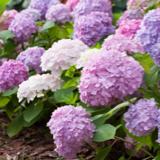
Unique looking succulents can make your rooms look better, also, they are low-maintenance and easiest plants to grow. Check out the 14 best indoor succulents for your home!
Are you looking for the one ingredient that’s capable of making any room look much better? The answer is indoor plants. After the failure of faux plants, indoor houseplants are back in fashion, and why not. A splatter of healthy greenery in your room can make it feel instantly welcoming and fresh. Another good reason to plant indoor plants is they purify air and in turn create a healthier living place.
Also Read: Plants for a Restful Sleep
Now face it, not all houseplants are easy to grow, especially for beginners. However, succulents, when grown as houseplants, adjust well to indoor conditions and are easiest to grow. And that’s why we’ve made a selection of succulents that are popular and easiest to grow.
Also Read: The Most Easy to Grow Houseplants
1. Burro’s Tail (Sedum morganianum)
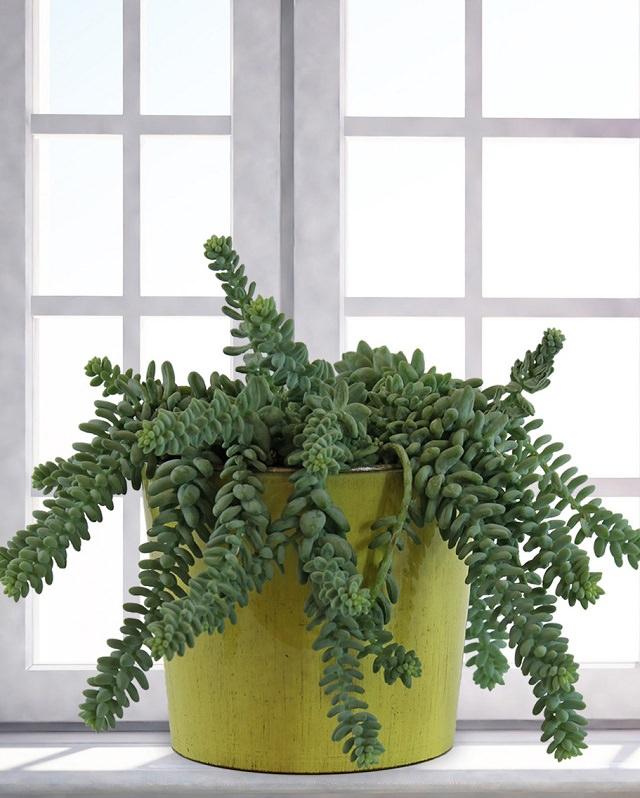
A native of Mexico, Burro’s tail is best planted in hanging baskets due to its fat trailing stems. Its beautiful gray-blue or gray-green leaves can grow up to 2 feet long. This plant does best when kept in a spot that receives bright sun.
Growing TipsLet the soil dry out between watering spells, and ensure that soil is kept on a dry side in times of winter dormancy, especially, if you’re growing it in a cool-temperate zone.Fertilize the plant once in summer using a 10:10:10 fertilizer or any cactus fertilizer.Leaves will fall off with the slightest of touches, so it is important the plant is placed where there will be a minimal disturbance.If you have to move it outside for the summer sun, ensure it will acclimate well before keeping it in a full sun.
2. Zebra Cactus (Haworthia fasciata)

Native to the African continent, the zebra plant perch on top of the soil and sports a neat for of leaves which boasts stunning horizontal white stripes. The beauty of this little plant is that it looks exceptional, takes a small space and requires little to no care.
Growing TipsUse a shallow pot since the roots don’t penetrate the soil deeply.Repot it at the interval of 12-24 months with the fresh succulent potting mix for optimum growth.Allow the soils to nearly dry out between watering spells. It’s important for all the succulents.The zebra plant is best placed in a bright spot so as not to expose the plant to the direct sun lest it becomes shriveled.
3. Aloe vera
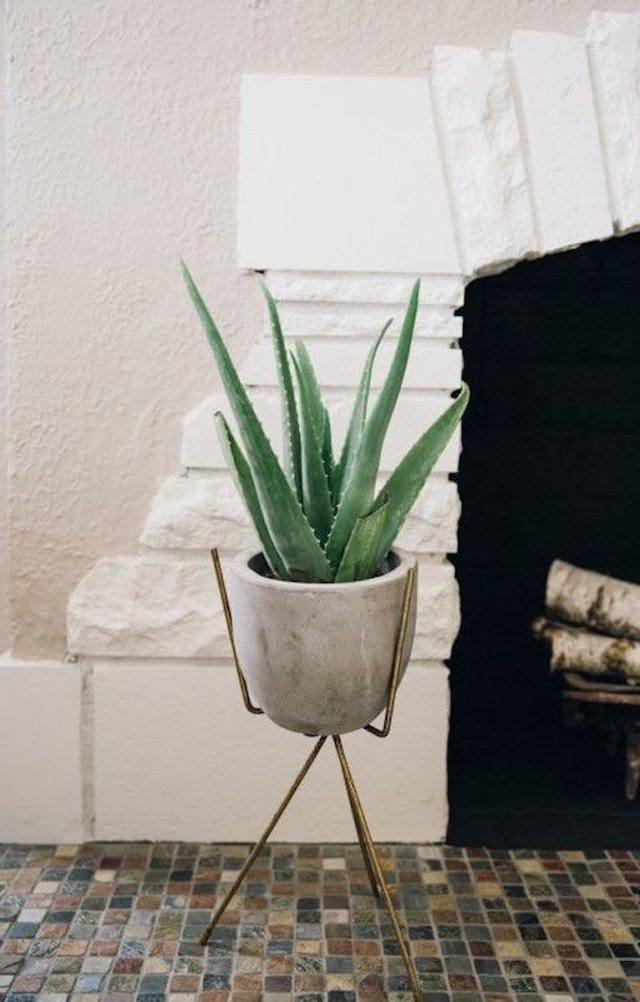
Aloe vera is a medicinal plant, a succulent whose sap has been used to treat sunburn and wounds for centuries. Medicinal value aside, aloe vera is also a great indoor plant. Because the sharp thorns along the margin of the leaves can cut people, the plant is best placed somewhere it can’t be accidentally brushed or fall.
Growing TipsLet the soil dry between soakings.Put it where it can get a couple of hours of sunlight daily.Fertilize the plant twice during the growing season using a balanced 10:10:10 fertilizer but don’t fertilize in winter.Do not repot unless the roots start to push their way out of the pot.
Also Read: How to Care for an Aloe Plants
4. Crown of Thorns (Euphorbia milii)
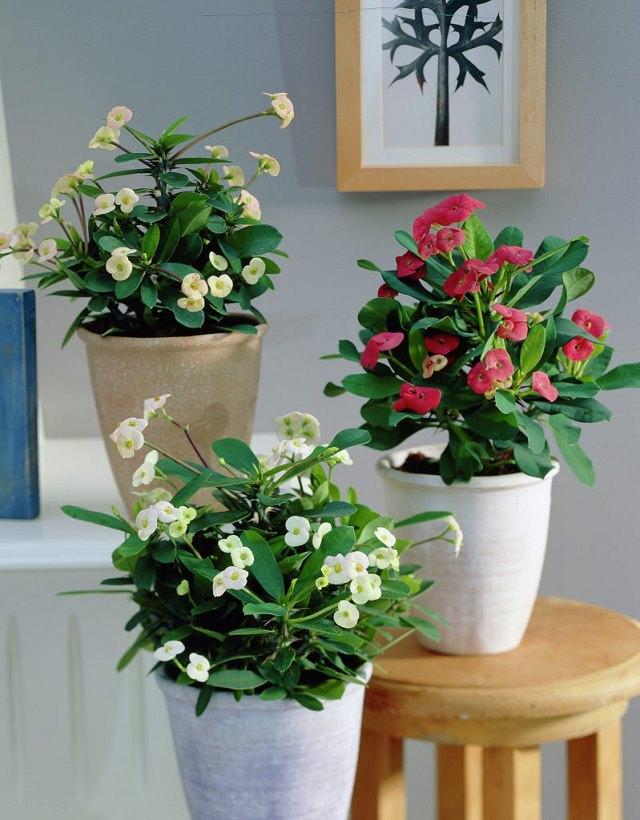
Native to Madagascar, this plant can bloom throughout the year provided you give it enough light. Long and spoon-shaped leaves appear at the end of its spiky branches, together with tiny flowers. The flowers are not noticeable because of their small size, but you will see yellow, red or salmon bracts surround them that looks attractive.
Growing TipsThis plant has low to moderate watering needs.Avoid letting the whole pot dry out or it will drop leaves.Direct light will give you the best bloom although the plant can also adapt to medium-light conditions.Fertilize 2-3 times with a balanced 10:10:10 fertilizer during the growing season.
5. Hens-and-Chicks
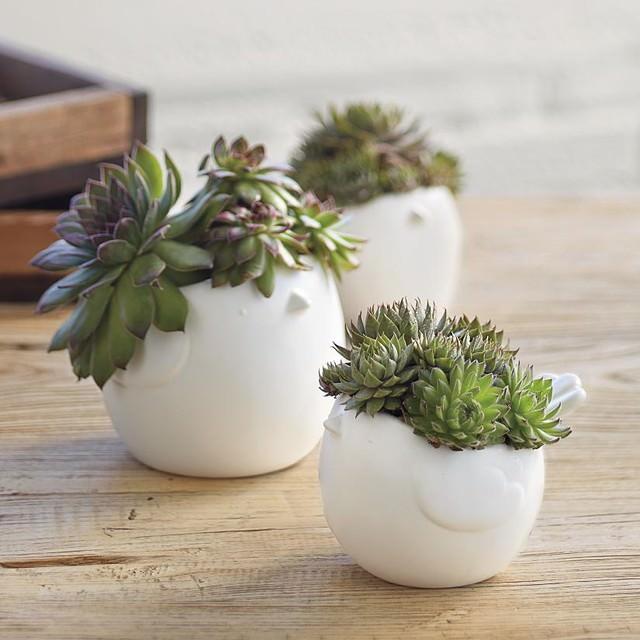
The Hens-and-Chick plants are another great succulent group of plants for indoor gardening, they form flat flowerlike rosettes that have rounded edges. These plants need to be allowed to dry a bit between watering since overwatering can cause rotting.
Growing TipsWater very infrequently during winter dormancy, if growing in a cooler region.Keep these plants in a bright spot, they can also tolerate light shade.You can propagate the plants by cuttings.
6. String of Bananas
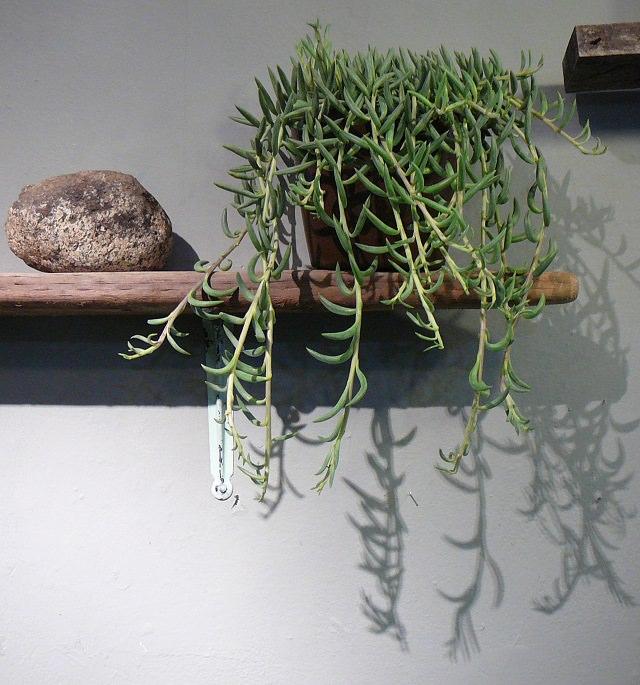
The trailing indoor succulent plant produces long tendrils of small banana-like leaves. The plant looks great when planted on its own and should be pruned regularly to grow thick and full. It also works beautifully when put in a pot containing other succulent indoor plants.
Growing TipsIt requires filtered sunlightWater the plant when soil is dry to touchIt does well in porous soil with excellent drainage.It is toxic, so you need to keep it away from pets and children who might munch it.
7. Lithops

Lithops are unique small and inconspicuous succulent plants that look like stones or pebbles. Growing lithops is very easy and don’t require much care.
Growing TipsKeep the plant in a sunny location, a south or west facing window would be best, away from drafts.Grow lithops in poor, well-drained soil.Stop watering your lithops plants in winter (in cooler zones).
8. Christmas Cactus (Schlumbergera x buckleyi)
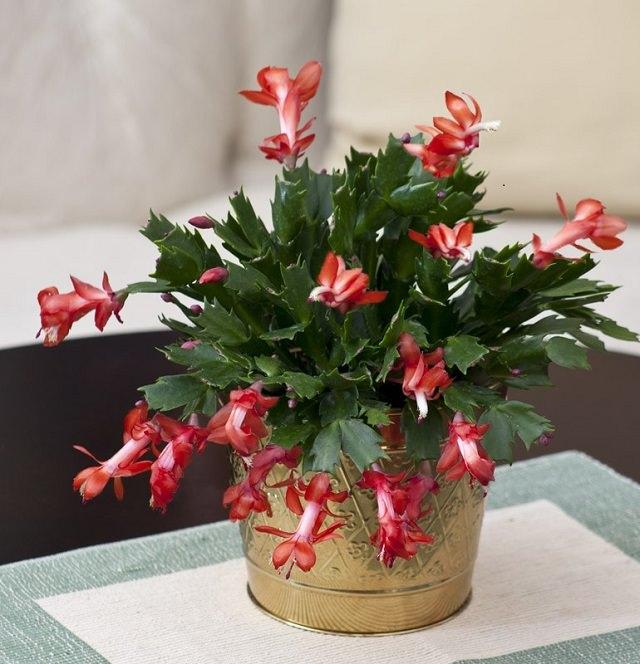
Christmas cactus needs no introduction, it is one of the most beautiful succulent plants, it looks good even without the flowers.
Growing TipsFor this plant to grow, allow the top 2 inches of the soil to dry between watering spells.Keep the plant on a dry side during winter. When it is in bud stage, be very careful since even the slightest overwatering or dehydration can lead to dropping of buds.
9. Ponytail palm (Beaucarnea recurvata)
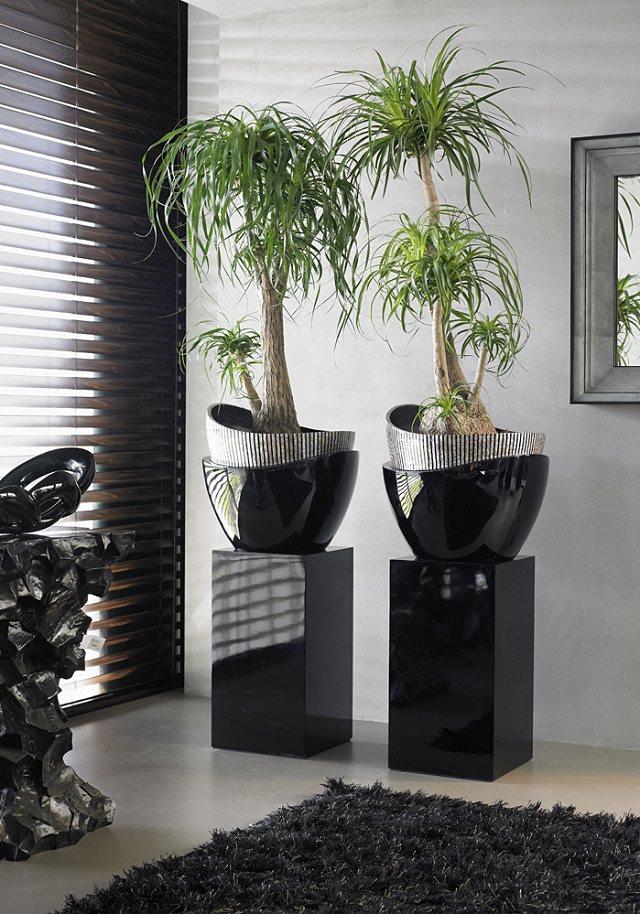
Ponytail palm is not a palm but a succulent. Probably, one of the most appealing houseplants and best in large houseplants. Its water is stored in the swollen stem base, which looks like elephant’s foot that’s why it’s also called “Elephant Foot Palm”.
Growing TipsIt grows well in sunny spots but can be grown in all day long bright indirect sunlight.It’s a plant and forget kind of plant when it comes to watering. Avoid watering regularly and let the top soil dry out before watering again.
10. Snake Plant
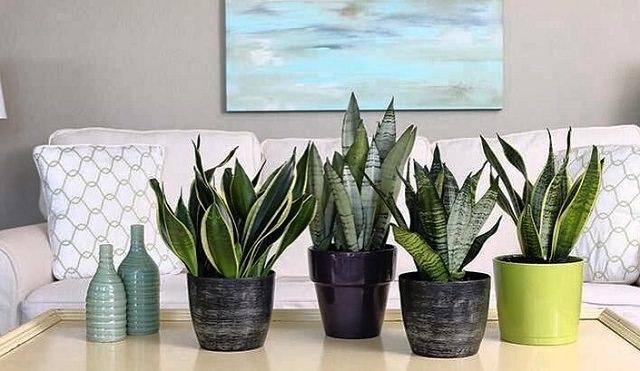
The snake plant or Mother-in-law’s tongue the most low maintenance plant in this list of best succulent plants for indoors and it is well-deserved! We also listed it in our post– Plants You can Grow without Sunlight. And why not, this succulent plant can survive in the darkest of corners and requires very low maintenance.
Growing TipsWater moderately.As snake plant is a very forgiving plant, you can place it in dim spots.
11. String of Pearls

The string of pearls is an exceptional trailing houseplant, very appealing indoors when grown in hanging baskets. You can experiment to grow it in different containers. Like other succulent houseplants growing string of pearls or beads is no different.
Growing TipsKeep the string of pearl plant in a bright light.Be careful with watering, this plant has low watering needs but in warmer regions, moderate watering is required.
12. Panda Plant (Kalanchoe tomentosa)
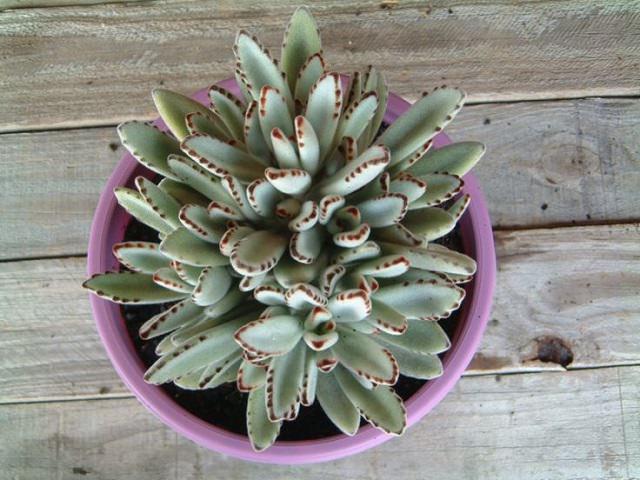
The silver gray hair of this plant makes it look fuzzy, the leaves are fat like other succulents and have rusty color on edges, like many other plants of kalanchoe genus the plant forms flowers too. However, they rarely bloom in indoor conditions.
Growing TipsKeeping the panda plant in a spot that receives bright indirect light and a couple of hours of direct sunlight is a good idea.Water infrequently and let the plant to dry out between the watering spells.Feed the plant once in a month during the growing season.Save the plant from cold and draft, normal room temperature is perfect.
13. Kalanchoe blossfeldiana
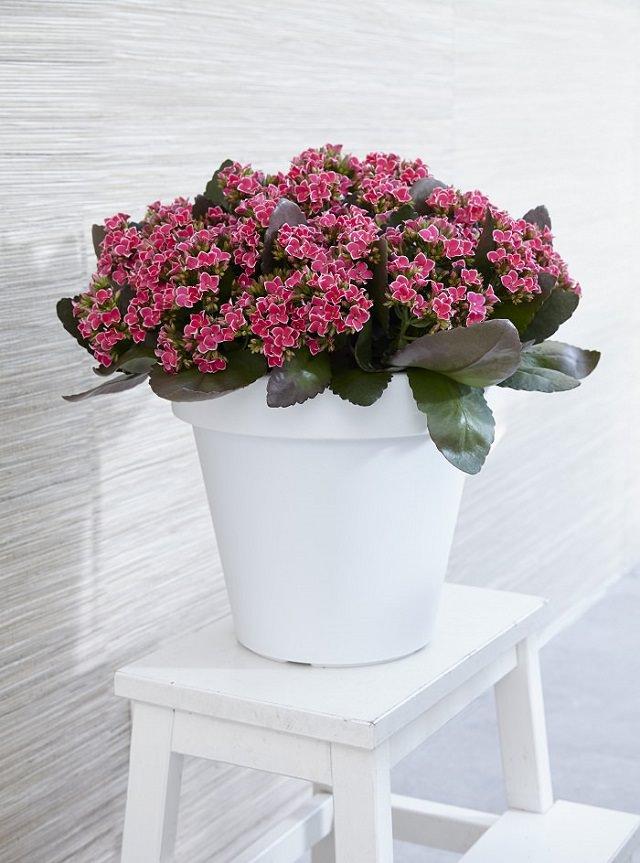
Kalanchoe blossfeldiana is one of the best flowering houseplants you can grow. Plants of this genus grow best outdoors in warm climates. However, it can be grown indoors. This flowering succulent comes in a variety of colors.
Growing TipsLow watering needs.The plant needs to be in a sunny spot to bloom.
Also Read: Flowering Houseplants
14. Pencil Cactus (Euphorbia tirucalli)

Pencil cactus became one of the most popular succulent houseplants from last few years and why not this unique African plant can grow up to 6 feet tall indoors and looks so different, quite a few houseplants like fiddle leaf fig can achieve such height.
Growing TipsKeep the plant near a sunny window.Water every couple of weeks, the plant has low watering needs.Use well-drained, gritty soil.Repot the plant every year or when you find it rootbound.
Are you looking for the one ingredient that’s capable of making any room look much better? The answer is indoor plants. After the failure of faux plants, indoor houseplants are back in fashion, and why not. A splatter of healthy greenery in your room can make it feel instantly welcoming and fresh. Another good reason to plant indoor plants is they purify air and in turn create a healthier living place.
Also Read: Plants for a Restful Sleep
Now face it, not all houseplants are easy to grow, especially for beginners. However, succulents, when grown as houseplants, adjust well to indoor conditions and are easiest to grow. And that’s why we’ve made a selection of succulents that are popular and easiest to grow.
Also Read: The Most Easy to Grow Houseplants
1. Burro’s Tail (Sedum morganianum)

A native of Mexico, Burro’s tail is best planted in hanging baskets due to its fat trailing stems. Its beautiful gray-blue or gray-green leaves can grow up to 2 feet long. This plant does best when kept in a spot that receives bright sun.
Growing TipsLet the soil dry out between watering spells, and ensure that soil is kept on a dry side in times of winter dormancy, especially, if you’re growing it in a cool-temperate zone.Fertilize the plant once in summer using a 10:10:10 fertilizer or any cactus fertilizer.Leaves will fall off with the slightest of touches, so it is important the plant is placed where there will be a minimal disturbance.If you have to move it outside for the summer sun, ensure it will acclimate well before keeping it in a full sun.
2. Zebra Cactus (Haworthia fasciata)

Native to the African continent, the zebra plant perch on top of the soil and sports a neat for of leaves which boasts stunning horizontal white stripes. The beauty of this little plant is that it looks exceptional, takes a small space and requires little to no care.
Growing TipsUse a shallow pot since the roots don’t penetrate the soil deeply.Repot it at the interval of 12-24 months with the fresh succulent potting mix for optimum growth.Allow the soils to nearly dry out between watering spells. It’s important for all the succulents.The zebra plant is best placed in a bright spot so as not to expose the plant to the direct sun lest it becomes shriveled.
3. Aloe vera

Aloe vera is a medicinal plant, a succulent whose sap has been used to treat sunburn and wounds for centuries. Medicinal value aside, aloe vera is also a great indoor plant. Because the sharp thorns along the margin of the leaves can cut people, the plant is best placed somewhere it can’t be accidentally brushed or fall.
Growing TipsLet the soil dry between soakings.Put it where it can get a couple of hours of sunlight daily.Fertilize the plant twice during the growing season using a balanced 10:10:10 fertilizer but don’t fertilize in winter.Do not repot unless the roots start to push their way out of the pot.
Also Read: How to Care for an Aloe Plants
4. Crown of Thorns (Euphorbia milii)

Native to Madagascar, this plant can bloom throughout the year provided you give it enough light. Long and spoon-shaped leaves appear at the end of its spiky branches, together with tiny flowers. The flowers are not noticeable because of their small size, but you will see yellow, red or salmon bracts surround them that looks attractive.
Growing TipsThis plant has low to moderate watering needs.Avoid letting the whole pot dry out or it will drop leaves.Direct light will give you the best bloom although the plant can also adapt to medium-light conditions.Fertilize 2-3 times with a balanced 10:10:10 fertilizer during the growing season.
5. Hens-and-Chicks

The Hens-and-Chick plants are another great succulent group of plants for indoor gardening, they form flat flowerlike rosettes that have rounded edges. These plants need to be allowed to dry a bit between watering since overwatering can cause rotting.
Growing TipsWater very infrequently during winter dormancy, if growing in a cooler region.Keep these plants in a bright spot, they can also tolerate light shade.You can propagate the plants by cuttings.
6. String of Bananas

The trailing indoor succulent plant produces long tendrils of small banana-like leaves. The plant looks great when planted on its own and should be pruned regularly to grow thick and full. It also works beautifully when put in a pot containing other succulent indoor plants.
Growing TipsIt requires filtered sunlightWater the plant when soil is dry to touchIt does well in porous soil with excellent drainage.It is toxic, so you need to keep it away from pets and children who might munch it.
7. Lithops

Lithops are unique small and inconspicuous succulent plants that look like stones or pebbles. Growing lithops is very easy and don’t require much care.
Growing TipsKeep the plant in a sunny location, a south or west facing window would be best, away from drafts.Grow lithops in poor, well-drained soil.Stop watering your lithops plants in winter (in cooler zones).
8. Christmas Cactus (Schlumbergera x buckleyi)

Christmas cactus needs no introduction, it is one of the most beautiful succulent plants, it looks good even without the flowers.
Growing TipsFor this plant to grow, allow the top 2 inches of the soil to dry between watering spells.Keep the plant on a dry side during winter. When it is in bud stage, be very careful since even the slightest overwatering or dehydration can lead to dropping of buds.
9. Ponytail palm (Beaucarnea recurvata)

Ponytail palm is not a palm but a succulent. Probably, one of the most appealing houseplants and best in large houseplants. Its water is stored in the swollen stem base, which looks like elephant’s foot that’s why it’s also called “Elephant Foot Palm”.
Growing TipsIt grows well in sunny spots but can be grown in all day long bright indirect sunlight.It’s a plant and forget kind of plant when it comes to watering. Avoid watering regularly and let the top soil dry out before watering again.
10. Snake Plant

The snake plant or Mother-in-law’s tongue the most low maintenance plant in this list of best succulent plants for indoors and it is well-deserved! We also listed it in our post– Plants You can Grow without Sunlight. And why not, this succulent plant can survive in the darkest of corners and requires very low maintenance.
Growing TipsWater moderately.As snake plant is a very forgiving plant, you can place it in dim spots.
11. String of Pearls

The string of pearls is an exceptional trailing houseplant, very appealing indoors when grown in hanging baskets. You can experiment to grow it in different containers. Like other succulent houseplants growing string of pearls or beads is no different.
Growing TipsKeep the string of pearl plant in a bright light.Be careful with watering, this plant has low watering needs but in warmer regions, moderate watering is required.
12. Panda Plant (Kalanchoe tomentosa)

The silver gray hair of this plant makes it look fuzzy, the leaves are fat like other succulents and have rusty color on edges, like many other plants of kalanchoe genus the plant forms flowers too. However, they rarely bloom in indoor conditions.
Growing TipsKeeping the panda plant in a spot that receives bright indirect light and a couple of hours of direct sunlight is a good idea.Water infrequently and let the plant to dry out between the watering spells.Feed the plant once in a month during the growing season.Save the plant from cold and draft, normal room temperature is perfect.
13. Kalanchoe blossfeldiana

Kalanchoe blossfeldiana is one of the best flowering houseplants you can grow. Plants of this genus grow best outdoors in warm climates. However, it can be grown indoors. This flowering succulent comes in a variety of colors.
Growing TipsLow watering needs.The plant needs to be in a sunny spot to bloom.
Also Read: Flowering Houseplants
14. Pencil Cactus (Euphorbia tirucalli)

Pencil cactus became one of the most popular succulent houseplants from last few years and why not this unique African plant can grow up to 6 feet tall indoors and looks so different, quite a few houseplants like fiddle leaf fig can achieve such height.
Growing TipsKeep the plant near a sunny window.Water every couple of weeks, the plant has low watering needs.Use well-drained, gritty soil.Repot the plant every year or when you find it rootbound.
8
9
文章
Colorful
2017年05月23日

Plants grown indoors bring nature into the home but do you know there are plants that can help you sleep better? 14 Best Houseplants for a Restful Sleep. Take a look!
Plants are known to improve the overall appearance of your home, but do you know they also contributes to your overall health? There are plants that are actually known to have soothing properties and help if you have trouble sleeping from time to time, you can benefit from such plants– not only they detoxify your bedroom’s air, but help you get a warm good night sleep as well.
To start, here are 14 of the best plants you can grow. They add warmth, relaxing fragrance and effectively increase oxygen levels in your room, thus giving you a restful sleep. Try adding one of them in your bedroom to get a little dose of zen.1. Jasmine

The jasmine plant features lovely little white flowers and a warm intense scent known to induce relaxing qualities ever since the ancient times. Studies have found that Jasmine has sedative properties and can significantly reduce anxiety levels, thus giving a positive impact on sleep quality.
How to grow: Use soilless potting mix and plant your jasmine in a medium to large size pot. It’s best to place it in a warm spot with full sun exposure (at least 4-5 hours a day).
2. Gardenia
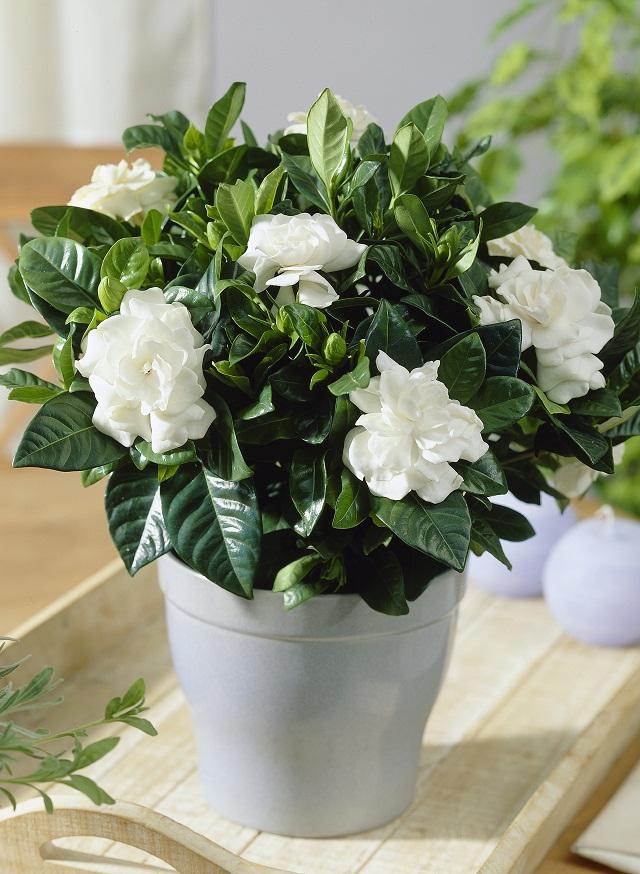
Like the jasmine, gardenia features big white flowers and an intoxicating fragrance that is incomparable– not to mention it also comes with a sedative effect. A study conducted in 2010 has shown that the sweet smell of gardenia flowers has the same effectiveness as that of valium in relaxing the body and brain. So instead of relying on sleeping pills, keeping a gardenia in your bedroom or outside your bedroom window could help you sleep more effectively.
Also Read: Most Fragrant Flowers
How to grow: Gardenia is a fussy plant and requires some care, you can read this growing guide in detail to learn how to grow gardenia in a container.
3. Bamboo Palm

The bamboo palm is great for removing trichloroethylene and benzene, two chemicals which are known to induce respiratory problems, thus a great AIR PURIFYING PLANT. With the plant’s excellent filtering property, you can expect a restful sleep when keeping it in your bedroom. It has been awarded a high purifying score of 8.4 in a study conducted by NASA.
How to grow: Bamboo palm grows perfectly well in shade or in indirect sunlight. It needs a slightly moist soil to thrive but at any case overwatering must be avoided.
Also Read: Best Tall Indoor Plants
4. Valerian
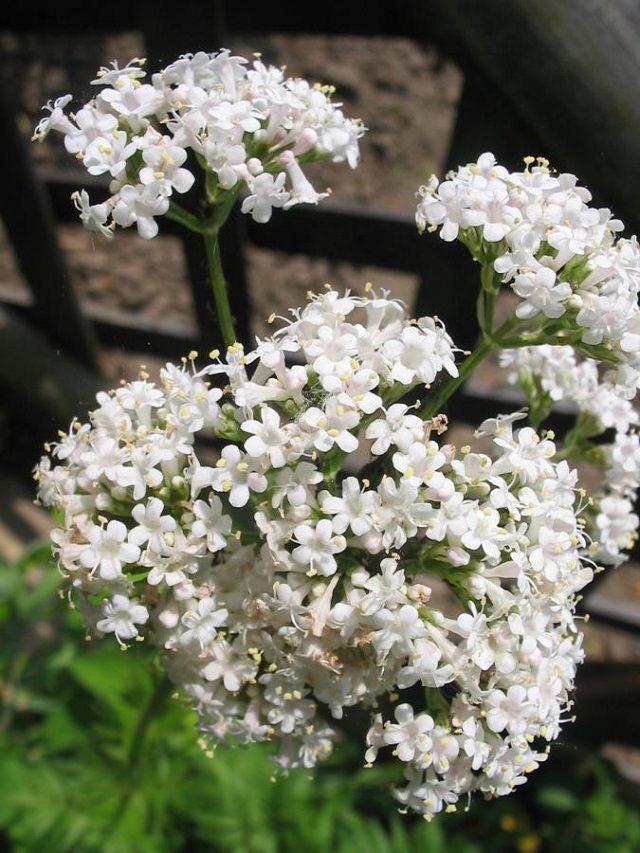
The valerian is a perennial flowering herb which features white, red or pink flowers during summer. It is popular among herbalists in treating anxiety, insomnia, and over-excitability, with its roots being commonly used as an ingredient in mild sedatives. When flowering, the valerian produces a calming vanilla fragrance which induces sleep.
How to grow: The plant will need a minimum sunlight exposure of six hours a day. It’s a good choice if your bedroom has a bright window ledge. It will require rich soil and a lot of water.
Also Read: How to Grow Valerian
5. Honeysuckle
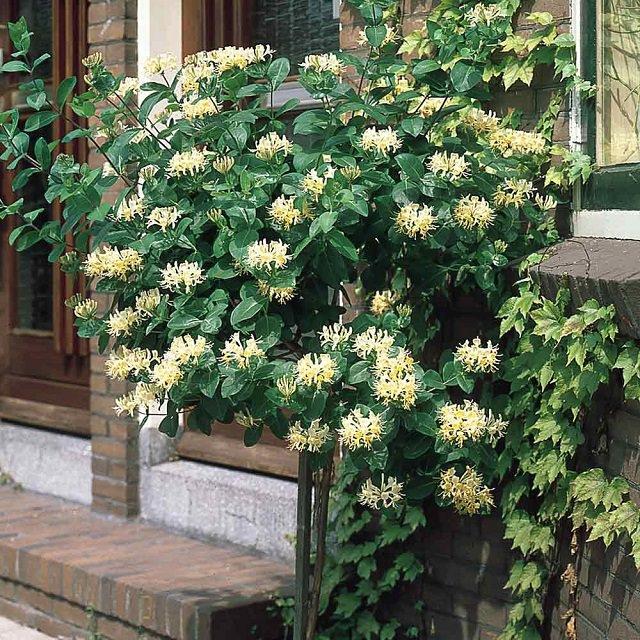
The warm mild fragrance of honeysuckle flowers gets more intense in the dark of the dusk. No wonder, it has the most intoxicating aroma. Growing honeysuckle indoors isn’t practical you may think as it’s a big vine. It is! But you can grow dwarf bush honeysuckle, it’s unique and grow only 4 feet tall. Plant it near a window where it will receive partial sun, it can tolerate shade too.
If you have space try growing a honeysuckle vine outside your bedroom window. Either in a large pot or on the ground.
How to grow: You can grow dwarf honeysuckle indoors near a south or west facing window that receives at least 5-6 hours of sun. Also, the honeysuckle prefers slightly moist soil so keep care of it.
Also Read: Best Vines for Containers
6. Rubber Tree Plant

Besides the ornamental aspect, rubber tree is considered as an air purifying plant. It’s proved that growing rubber tree indoors is beneficial as it cleanses the formaldehyde.
How to Grow: Avoid direct sunlight, especially afternoon sun. Otherwise, the leaves will eventually fall off. Place the plant on a bright and well-lit spot that receives indirect or morning sunlight. To read more on how to grow a rubber tree plant, click here!
7. Peace Lily

The peace lily plant has an ability to filter harmful toxins from the air. Apart from it looking exceptional, it also helps in getting rid of any impurities and airborne microbes that could disturb your sleep.
How to grow: Peace lilies are low maintenance plants, only requiring watering on a weekly basis, usually when top 2 inches soil seems dry. They often grow best in a shady spot.
8. Aloe Vera
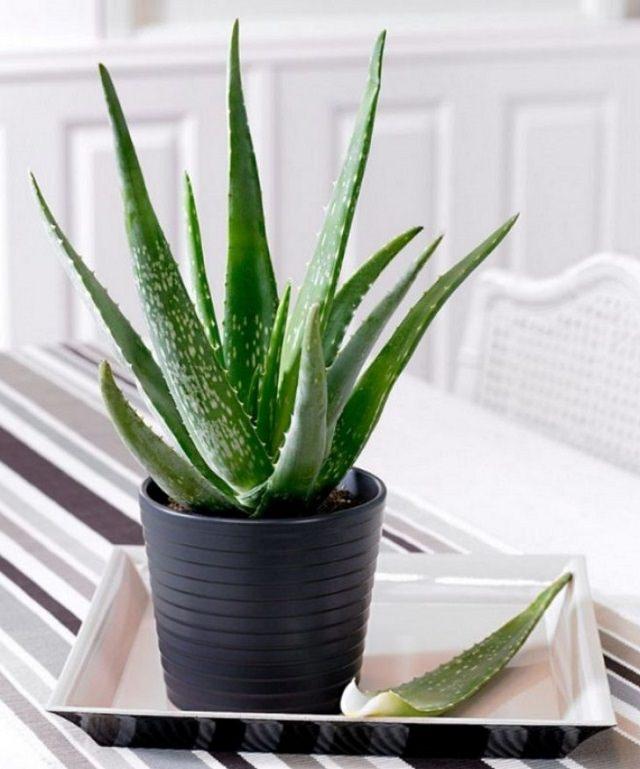
Aloe vera is widely known for its healing property, but it is also considered the most effective plant in terms of filtering out hazardous chemicals and toxins in the air. It lets out oxygen during nighttime, something which is not typical for plants, hence leaving you with a fresher and cleaner air for a more restful sleep. It also produces volatile which provides a positive effect on your immune system. By having an aloe vera inside your bedroom, you can expect a good night sleep.
How to grow: Aloe vera is very easy to care for since it doesn’t require frequent watering. It grows best on spots that receive some sun.
9. Spider Plant
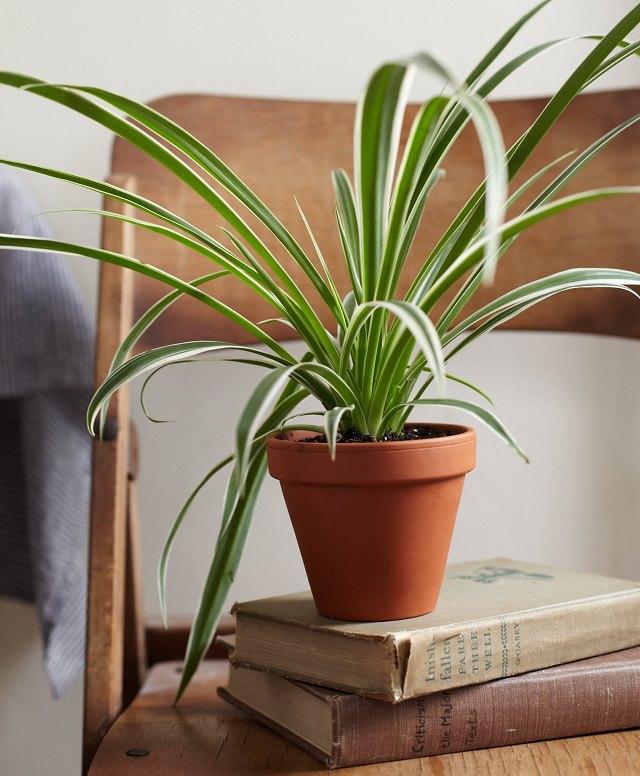
Spider plants are one of the most common house plants which made it to NASA’s list of the most excellent air filtering plants. Spider plants are capable of removing up to 90% of harmful formaldehyde in the air that surrounds them. Other than formaldehyde, they are also capable of filtering benzene, xylene, and carbon monoxide.
How to grow: Spider plants are very easy to grow. As long as they’re provided with a well-drained soil, enough water, and a bright light, they will thrive well.
Also Read: Easiest Houseplant
10. English Ivy plant
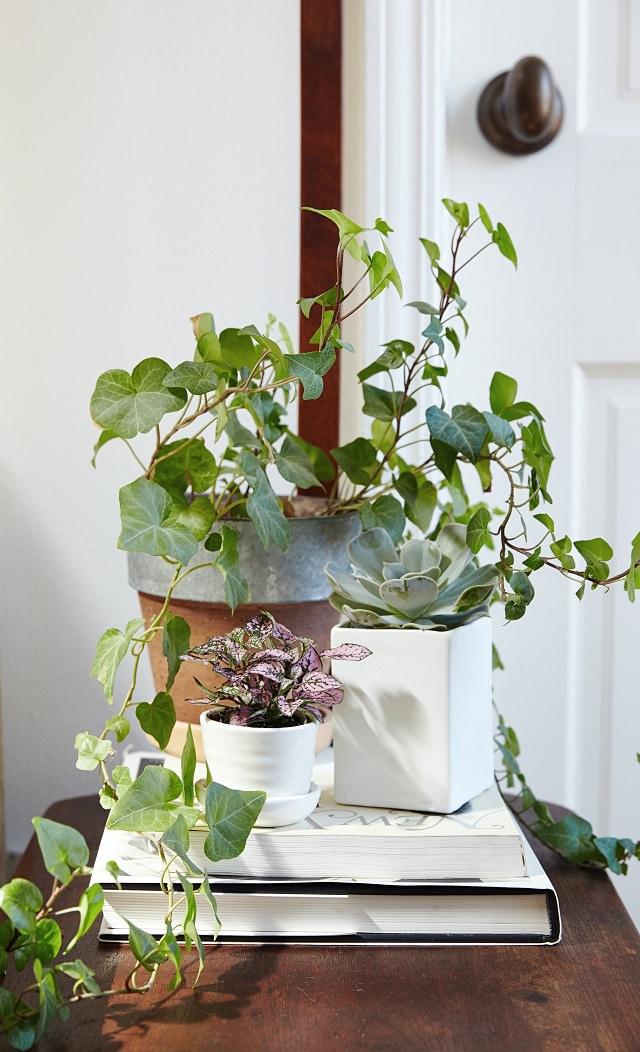
The English ivy plant is a leader when it comes to purifying air, it is also a very hardy plant and thrive in shade. All this makes it an excellent choice for bedrooms. Also, it is discovered to help those who suffer from allergy by purifying the air in its surroundings. With the air effectively purified, you are guaranteed to have a more restful sleep.
How to grow: An English ivy plant is toxic if ingested, which is why you should choose another plant to place in your bedroom if there are small children or pets with you. They grow well in moderate temperatures with moderate sunlight.
11. Lavender

The scent of lavender induces calmness. A study conducted in 2008 has found that the plant’s scent help soothe fussy babies and help them fall into a deep sleep stage. Other than that, research has shown that the lavender is effective for lowering heart rate and blood pressure. As an alternative for the plant, you can use lavender essential oil to get a better sleep.
How to grow: The plant grows best when placed in a bright window with full exposure to the sun. It only requires moderate watering. To learn more click here!
12. Snake plant

According to NASA, the snake plant is among the 10 best houseplants that help filter the air. It absorbs carbon dioxide while at the same time releases oxygen during nighttime, hence allowing you to achieve deep sleep. Through this process, you can expect a naturally clean and fresh air inside your bedroom.
How to grow: A snake plant is a succulent and doesn’t need that much of water or light, hence you can simply place it even in the darkest of corners of your room. It’s actually a low maintenance plant that is ideal for beginners.
Also Read: Plants that Grow without Sunlight
13. Pothos

All plants belong to the pothos family are very easy to grow and low maintenance. This beautiful can be grown in dim corners.
How to Grow: This attractive and hardy vine prefers bright indirect light and a draft free place. It can even grow in really low light and needs slightly moist soil.
14. Hoya
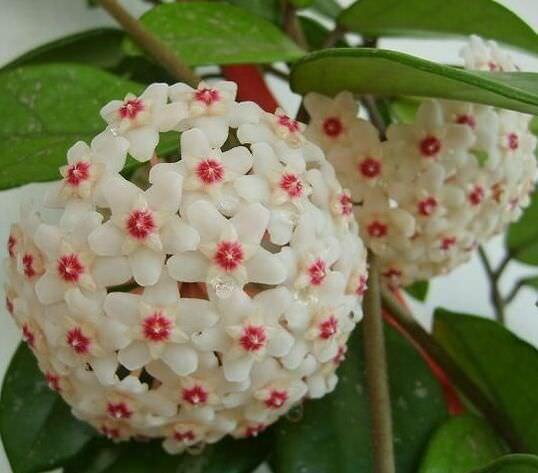
Thick green leathery leaves and long slender stems– the hoya (wax plant) looks beautiful even without its cluster of uniform star-shaped flowers. Sweetly scented hoya flowers can be a wonderful addition to your bedroom and help in providing a RESTFUL SLEEP.
How to grow: Keep the plant in a spot that receives bright indirect sun all day long, a couple of hours of morning sun would be better. Must remember hoya plant requires moderate watering and warm room temperature.
Tips to consider when introducing plants in your room
If you plan on putting houseplants inside your house, make sure you consider the following tips:
Check if they are toxic to the kids and pets inside of your house.Wipe the leaves once a week to make sure the plants can perform their best.Mix your plants with the ones that purify air and the ones that induce deep sleep through their scents.NASA recommends keeping between 15 to 18 air purifying plants in an 1800 sq. ft house, with only a few of them in each bedroom.
Plants are known to improve the overall appearance of your home, but do you know they also contributes to your overall health? There are plants that are actually known to have soothing properties and help if you have trouble sleeping from time to time, you can benefit from such plants– not only they detoxify your bedroom’s air, but help you get a warm good night sleep as well.
To start, here are 14 of the best plants you can grow. They add warmth, relaxing fragrance and effectively increase oxygen levels in your room, thus giving you a restful sleep. Try adding one of them in your bedroom to get a little dose of zen.1. Jasmine

The jasmine plant features lovely little white flowers and a warm intense scent known to induce relaxing qualities ever since the ancient times. Studies have found that Jasmine has sedative properties and can significantly reduce anxiety levels, thus giving a positive impact on sleep quality.
How to grow: Use soilless potting mix and plant your jasmine in a medium to large size pot. It’s best to place it in a warm spot with full sun exposure (at least 4-5 hours a day).
2. Gardenia

Like the jasmine, gardenia features big white flowers and an intoxicating fragrance that is incomparable– not to mention it also comes with a sedative effect. A study conducted in 2010 has shown that the sweet smell of gardenia flowers has the same effectiveness as that of valium in relaxing the body and brain. So instead of relying on sleeping pills, keeping a gardenia in your bedroom or outside your bedroom window could help you sleep more effectively.
Also Read: Most Fragrant Flowers
How to grow: Gardenia is a fussy plant and requires some care, you can read this growing guide in detail to learn how to grow gardenia in a container.
3. Bamboo Palm

The bamboo palm is great for removing trichloroethylene and benzene, two chemicals which are known to induce respiratory problems, thus a great AIR PURIFYING PLANT. With the plant’s excellent filtering property, you can expect a restful sleep when keeping it in your bedroom. It has been awarded a high purifying score of 8.4 in a study conducted by NASA.
How to grow: Bamboo palm grows perfectly well in shade or in indirect sunlight. It needs a slightly moist soil to thrive but at any case overwatering must be avoided.
Also Read: Best Tall Indoor Plants
4. Valerian

The valerian is a perennial flowering herb which features white, red or pink flowers during summer. It is popular among herbalists in treating anxiety, insomnia, and over-excitability, with its roots being commonly used as an ingredient in mild sedatives. When flowering, the valerian produces a calming vanilla fragrance which induces sleep.
How to grow: The plant will need a minimum sunlight exposure of six hours a day. It’s a good choice if your bedroom has a bright window ledge. It will require rich soil and a lot of water.
Also Read: How to Grow Valerian
5. Honeysuckle

The warm mild fragrance of honeysuckle flowers gets more intense in the dark of the dusk. No wonder, it has the most intoxicating aroma. Growing honeysuckle indoors isn’t practical you may think as it’s a big vine. It is! But you can grow dwarf bush honeysuckle, it’s unique and grow only 4 feet tall. Plant it near a window where it will receive partial sun, it can tolerate shade too.
If you have space try growing a honeysuckle vine outside your bedroom window. Either in a large pot or on the ground.
How to grow: You can grow dwarf honeysuckle indoors near a south or west facing window that receives at least 5-6 hours of sun. Also, the honeysuckle prefers slightly moist soil so keep care of it.
Also Read: Best Vines for Containers
6. Rubber Tree Plant

Besides the ornamental aspect, rubber tree is considered as an air purifying plant. It’s proved that growing rubber tree indoors is beneficial as it cleanses the formaldehyde.
How to Grow: Avoid direct sunlight, especially afternoon sun. Otherwise, the leaves will eventually fall off. Place the plant on a bright and well-lit spot that receives indirect or morning sunlight. To read more on how to grow a rubber tree plant, click here!
7. Peace Lily

The peace lily plant has an ability to filter harmful toxins from the air. Apart from it looking exceptional, it also helps in getting rid of any impurities and airborne microbes that could disturb your sleep.
How to grow: Peace lilies are low maintenance plants, only requiring watering on a weekly basis, usually when top 2 inches soil seems dry. They often grow best in a shady spot.
8. Aloe Vera

Aloe vera is widely known for its healing property, but it is also considered the most effective plant in terms of filtering out hazardous chemicals and toxins in the air. It lets out oxygen during nighttime, something which is not typical for plants, hence leaving you with a fresher and cleaner air for a more restful sleep. It also produces volatile which provides a positive effect on your immune system. By having an aloe vera inside your bedroom, you can expect a good night sleep.
How to grow: Aloe vera is very easy to care for since it doesn’t require frequent watering. It grows best on spots that receive some sun.
9. Spider Plant

Spider plants are one of the most common house plants which made it to NASA’s list of the most excellent air filtering plants. Spider plants are capable of removing up to 90% of harmful formaldehyde in the air that surrounds them. Other than formaldehyde, they are also capable of filtering benzene, xylene, and carbon monoxide.
How to grow: Spider plants are very easy to grow. As long as they’re provided with a well-drained soil, enough water, and a bright light, they will thrive well.
Also Read: Easiest Houseplant
10. English Ivy plant

The English ivy plant is a leader when it comes to purifying air, it is also a very hardy plant and thrive in shade. All this makes it an excellent choice for bedrooms. Also, it is discovered to help those who suffer from allergy by purifying the air in its surroundings. With the air effectively purified, you are guaranteed to have a more restful sleep.
How to grow: An English ivy plant is toxic if ingested, which is why you should choose another plant to place in your bedroom if there are small children or pets with you. They grow well in moderate temperatures with moderate sunlight.
11. Lavender

The scent of lavender induces calmness. A study conducted in 2008 has found that the plant’s scent help soothe fussy babies and help them fall into a deep sleep stage. Other than that, research has shown that the lavender is effective for lowering heart rate and blood pressure. As an alternative for the plant, you can use lavender essential oil to get a better sleep.
How to grow: The plant grows best when placed in a bright window with full exposure to the sun. It only requires moderate watering. To learn more click here!
12. Snake plant

According to NASA, the snake plant is among the 10 best houseplants that help filter the air. It absorbs carbon dioxide while at the same time releases oxygen during nighttime, hence allowing you to achieve deep sleep. Through this process, you can expect a naturally clean and fresh air inside your bedroom.
How to grow: A snake plant is a succulent and doesn’t need that much of water or light, hence you can simply place it even in the darkest of corners of your room. It’s actually a low maintenance plant that is ideal for beginners.
Also Read: Plants that Grow without Sunlight
13. Pothos

All plants belong to the pothos family are very easy to grow and low maintenance. This beautiful can be grown in dim corners.
How to Grow: This attractive and hardy vine prefers bright indirect light and a draft free place. It can even grow in really low light and needs slightly moist soil.
14. Hoya

Thick green leathery leaves and long slender stems– the hoya (wax plant) looks beautiful even without its cluster of uniform star-shaped flowers. Sweetly scented hoya flowers can be a wonderful addition to your bedroom and help in providing a RESTFUL SLEEP.
How to grow: Keep the plant in a spot that receives bright indirect sun all day long, a couple of hours of morning sun would be better. Must remember hoya plant requires moderate watering and warm room temperature.
Tips to consider when introducing plants in your room
If you plan on putting houseplants inside your house, make sure you consider the following tips:
Check if they are toxic to the kids and pets inside of your house.Wipe the leaves once a week to make sure the plants can perform their best.Mix your plants with the ones that purify air and the ones that induce deep sleep through their scents.NASA recommends keeping between 15 to 18 air purifying plants in an 1800 sq. ft house, with only a few of them in each bedroom.
3
3





